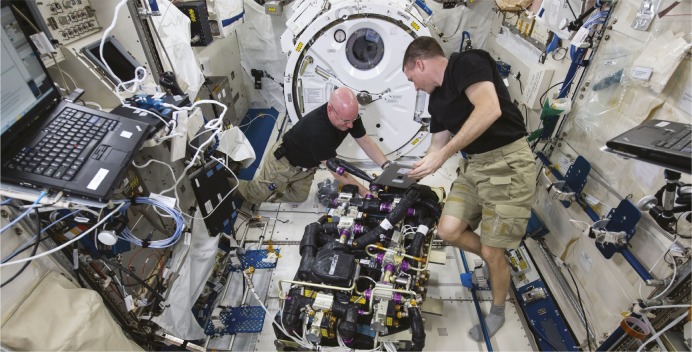Potential biomarker for chronic fatigue syndrome
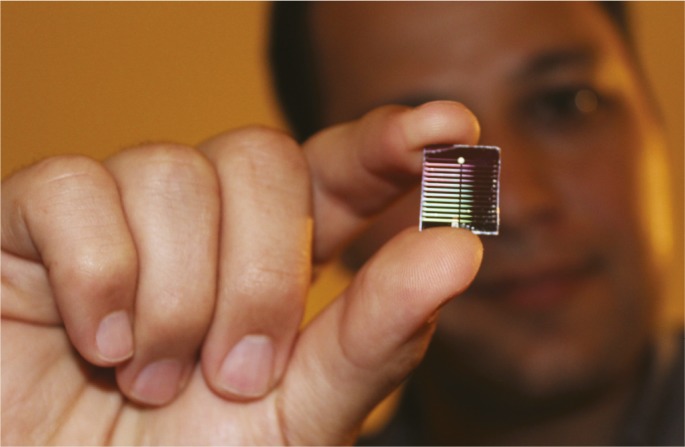
Diagnostic device for ME/CFS.
More than 2 million Americans are afflicted by myalgic encephalomyelitis/chronic fatigue syndrome (ME/CFS), a debilitating condition of uncertain etiology thought to be triggered by infectious agents, among other putative factors. However, a diagnostic biomarker continues to elude researchers. Based on the hypothesis that exposing blood cells to salt-induced osmotic stress forces the cells to devour ATP, a cellular energy metabolite thought to be deficient in ME/CFS patients, R. Esfandyarpour et al. (pp. 10250–10257) developed a blood-based assay for ME/CFS. The assay, performed using a high-throughput nanoelectronic needle array, measures changes in electrical impedance in blood cells exposed to plasma salt concentrations of 200 mmol/L—a hyperosmotic stress that mimics the exertion-induced malaise experienced by patients. Comparison of the electrical response of osmotically stressed blood cells from a bedridden patient and healthy control revealed marked differences in impedance changes, providing the basis of a potential diagnostic signature for ME/CFS. The authors validated the signature in a separate cohort of 20 healthy controls and 20 ME/CFS patients of varying disease severity who had been diagnosed by a physician using the established Canadian Consensus Criteria (CCC). Plasma samples used within 5 hours of preparation at 200 cells/µL yielded the most reproducible results. Additionally, the authors paired the assay with a machine learning algorithm to develop a diagnostic classifier for new patients. According to the authors, though the assay’s mechanistic underpinnings remain unexplored, the findings present a potential blood-based diagnostic biomarker that can complement CCC and aid drug-screening efforts. — P.N.
Medieval skeletons reveal ancient bone disorder
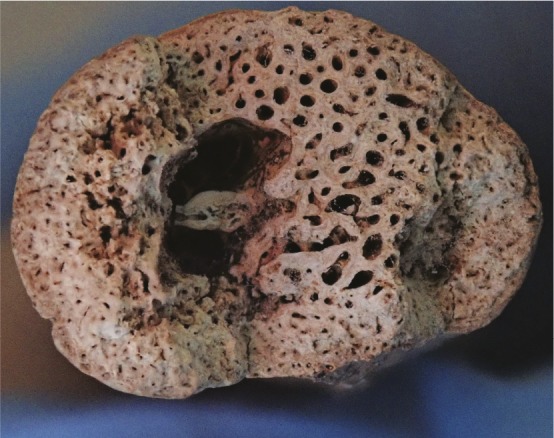
Collarbone shows evidence of bone disease.
Paget’s disease of bone is a common metabolic bone disorder. Signs of Paget’s disease have been reported in archaeological remains dating back to the Roman Era, but the natural history of the disease remains unclear. Barry Shaw, Carla Burrell, Darrell Green, et al. (pp. 10463–10472) used protein sequence-based methods to diagnose an ancient and atypical form of Paget’s disease found in six medieval skeletons excavated in the northwestern England. Pathological changes resembling contemporary Paget’s disease were extensive, affecting up to 75% of individual skeletons. Moreover, disease prevalence in the remaining collection of 130 medieval skeletons excavated at the same site was high, and the age-at-death estimations for the skeletons showing signs of the disease were low. Despite these atypical features, paleoproteomic analysis revealed that samples from the affected skeletons contained sequences of an abnormal form of the protein p62, which plays a central role in Paget’s disease. In addition, RNA sequencing revealed that a malignant bone tumor from a skeleton with extensive disease showed high expression of the microRNA miR-16, which has been reported in contemporary cases of Paget’s disease. According to the authors, the findings suggest that ancient remains affected by other skeletal disorders may hold a chemical record amenable to similar molecular interrogation. — J.W.
Mathematical theorem predicts mushroom gatherers’ search
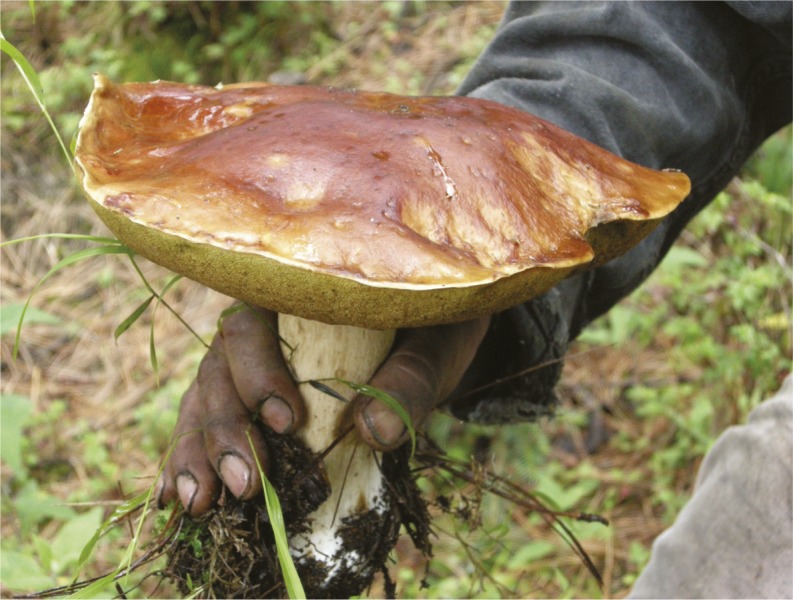
Man holding a xotoma (Boletus sp.).
Foraging for resources requires environmental knowledge, consumes energy, and exposes foragers to predation and other hazards. Mobile foragers use strategies to optimize success rates and minimize costs. Luis Pacheco-Cobos, Cody Ross, et al. (pp. 10339–10347) report that Nahua mushroom collectors use search heuristics with a “giving-up time” (GUT) that corresponds to the theoretical optimum predicted by the marginal value theorem (MVT). Building on a foraging strategy framework known as area-restricted search (ARS), along with findings linking resource-finding rates with step size and turning angles, the authors devised a theoretical model to estimate GUTs and identify distinct search patterns suitable for patchily distributed resources, such as mushrooms. Applied to a field study that used GPS to track mushroom hunters from a community in La Malinche National Park, Mexico, the model revealed that Nahua foragers searched for an amount of time predicted by MVT. MVT has not been widely applied to human foraging research and other related patterns. In addition, the findings could aid a diverse range of applications, such as warehouse product distribution and search-and-rescue efforts, according to the authors. — T.J.
Activating innate immunity augments cancer immunotherapy
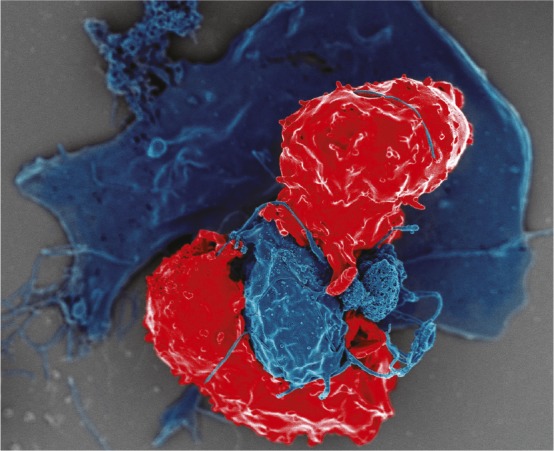
Scanning electron micrograph of Tregs (red) interacting with antigen-presenting cells (blue). Tregs suppress antitumor immune responses by T cells. Image courtesy of Flickr/NIH Image Gallery.
Ipilimumab, an antibody against the immune checkpoint protein CTLA-4, is a mainline cancer immunotherapy drug. However, many cancer patients are unresponsive to ipilimumab. In mice, anti–CTLA-4 antibodies confer antitumor immunity not only by overriding CTLA-4, which reins in the immune system, but also by depleting regulatory T cells (Tregs), which infiltrate tumors and suppress immune response. Naveen Sharma et al. (pp. 10453–10462) combined a mouse version of the anti–CTLA-4 antibody, which revs up adaptive immunity, with a drug targeting the innate immune receptors Toll-like receptor 1/2 (TLR 1/2) in mouse models of melanoma and pancreatic cancer. Administration of the TLR1/2 ligand Pam3CSK4, along with anti–CTLA-4, to tumor-ridden mice reduced tumor burden and increased survival to a greater extent than anti–CTLA-4 alone; the effect was restricted to the tumor microenvironment and mediated by the enhanced function of tumor-infiltrating CD8+ T cells and CD4+ effector T cells. Mice administered the combination exhibited higher ratios of both CD8+ T cells and CD4+ effector T cells to Tregs, compared with mice that received anti–CTLA-4 alone, suggesting that the combination depletes Tregs within tumors. Treg-depletion was dependent on macrophages studded with the receptor FcγRIV and was likely mediated through a mechanism termed antibody-dependent cellular cytotoxicity, in which macrophages eliminate Tregs coated with anti–CTLA-4. The authors also showed that FCγRIIIA, the human version of FcγRIV, is upregulated in human immune cells exposed to Pam3CSK4, suggesting that Pam3CSK4 might augment ipilimumab efficacy in patients by depleting tumor Tregs—a hypothesis being tested at pharmaceutical companies. According to the authors, the findings suggest the therapeutic potential of combining ipilimumab with TLR1/2 ligands for cancer immunotherapy. — P.N.
Hypoimmunogenic human stem cells
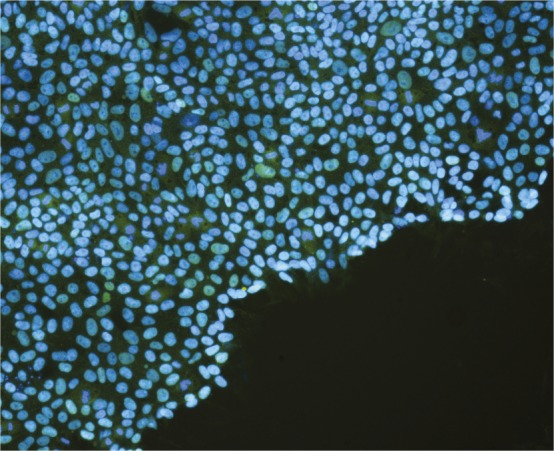
HLA knockout human pluripotent stem cells retain pluripotency (blue, nuclei; green, NANOG marker).
Lack of universal donor cells limits the expansion of stem cell therapy. Certain molecules expressed on an individual’s cells can serve as unique identifiers that tag the cells as invaders when the cells are transplanted to another individual. Xiao Han et al. (pp. 10441–10446) report a technique for creating a supply of human pluripotent cells devoid of such cell-surface molecular identifiers, shielding the cells from the immune system. To prevent immune attack by T cells, a major cause of immune rejection, the authors used the CRISPR/Cas9 system to delete several HLA class Ia genes and ablate the expression of HLA class II genes, which encode surface proteins that serve as cellular fingerprints. Cells of the innate immune system can also mediate transplant rejection by engulfing perceived invaders. Hence, the authors used the CRISPR/Cas9 system to turn on the expression of three immunomodulatory molecules: PD-L1, HLA-G, and CD47. In vitro assays and in vivo responses in mice showed blunted, but not entirely eliminated, T cell activity. Natural killer cell-mediated cytotoxicity was inhibited by 84%, and engulfment by macrophages was reduced by 86.6%. According to the authors, generating potential universal donor stem cells would require the development of robust in vivo model systems in which to further test this approach. — T.H.D.
Maternal obesity and sperm RNA
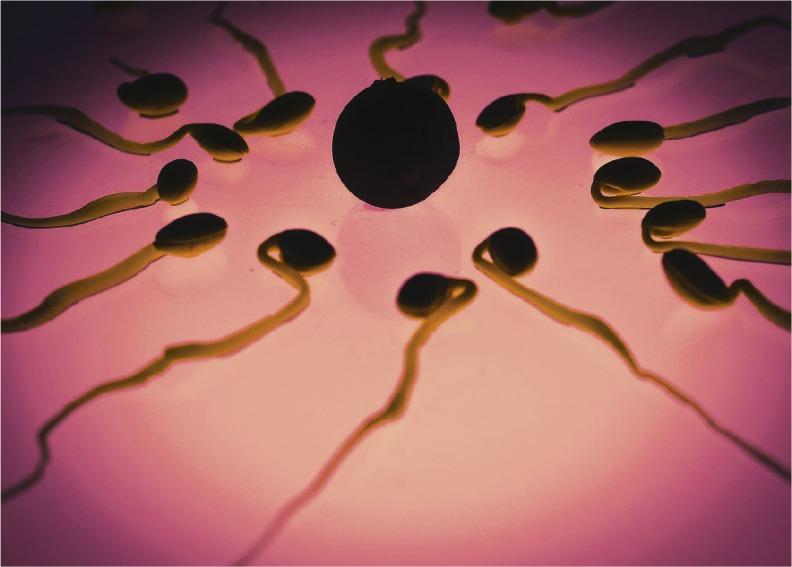
Small RNA in sperm may help transmit effects of maternal obesity across generations. Image courtesy of Pixabay/TBIT.
Recent work has shown that maternal obesity in mice is associated with physiological and behavioral changes that affect up to three generations of offspring. Gitalee Sarker et al. (pp. 10547–10556) found that levels of certain small molecules in sperm called tRNA-derived small RNAs (tsRNAs) were significantly higher in the sperm of males born to mothers fed a high-fat diet (HFD), compared to males from mothers fed a normal diet. The authors extracted sperm tsRNA from the offspring of HFD-fed and normal diet-fed mothers and injected it into normal mouse zygotes to generate HFD-tsRNA and control offspring, respectively. Compared with controls, offspring born through the HFD-tsRNA injection exhibited increased addictive-like behaviors, such as an increased preference for and consumption of HFD, sucrose, and alcohol, and enhanced sensitivity to amphetamines. Additionally, HFD-tsRNA offspring developed obesity and impaired insulin sensitivity compared with controls, especially when given free access to HFD and sucrose. HFD-tsRNAs targeted several key genes involved in addiction and obesity, and both the HFD sperm donors and HFD-tsRNA offspring showed altered expression of these genes, compared with controls in brain regions involved in reward. According to the authors, the results suggest that sperm tsRNAs contribute to the transgenerational transmission of addictive and obesity-causing traits induced by maternal HFD. — B.D.
Heat-tolerant corals create bleach-resistant nurseries
Coral reefs worldwide face widespread bleaching due to rising ocean temperatures. Some coral species include individual colonies thriving in high-heat environments, and such colonies have been proposed as potential nursery stock for coral restoration efforts. However, the heat tolerance could stem from adjustable physiology, microbiome-related or symbiont-related effects. To test whether colonies are likely to retain heat tolerance when transferred to nurseries, Megan Morikawa and Stephen Palumbi (pp. 10586–10591) placed 800 fragments from 80 colonies with varying heat tolerance from four coral species in nurseries at Sili Reef in American Samoa in the South Pacific Ocean in the winter of 2014. After the 2015 global bleaching event in the Samoan archipelago, nursery colonies from heat-tolerant parent corals showed twofold to threefold less bleaching, compared with corals from less heat-tolerant parent species, even after 8 months of acclimatization in a common garden. These colonies also retained relatively higher genetic diversity. Additionally, the authors found a correlation between the bleaching of nubbins, which are biological replicates of parent colonies, with the parent colony’s pool of origin and symbiont genus. According to the authors, selecting coral colonies that can withstand warm ocean conditions could aid the development of nurseries for climate-resilient corals. — T.G.
Brain fluid shifts following spaceflight
NASA astronauts Scott Kelly (Left) and Terry Virts (Right) work inside the International Space Station’s Japanese experiment module. Image courtesy of NASA.
One of the physiological consequences of long-term spaceflight is a headward shift of body fluids. Such cephalic fluid shifts may be tied to clinical syndromes of visual acuity changes associated with long-term spaceflight. The persistence of changes in cerebrospinal fluid volume following spaceflight has not been previously quantified. Angelique Van Ombergen et al. (pp. 10531–10536) conducted MRI scans on 11 cosmonauts before and after their assignments on the International Space Station, with an average mission duration of 169 days in space. The authors also conducted follow-up scans 7 months after spaceflight. The volume of the cosmonauts’ brain ventricles increased by an average of 12% after spaceflight—a potential mechanism to cope with the increased fluid volume. In the follow-up scans, the cosmonauts’ ventricle sizes had decreased but did not return to baseline levels, with overall ventricle volume around 6% larger than preflight volume. The patterns of ventricle size variation suggest decreased cerebrospinal fluid reabsorption during microgravity exposure, possibly partly due to the compression of cranial venous structures associated with reabsorption. According to the authors, although the ventricle size effects and cosmonauts’ altered visual acuity both persisted several months after their return to Earth, further studies are needed to establish links between the two phenomena. — P.G.



